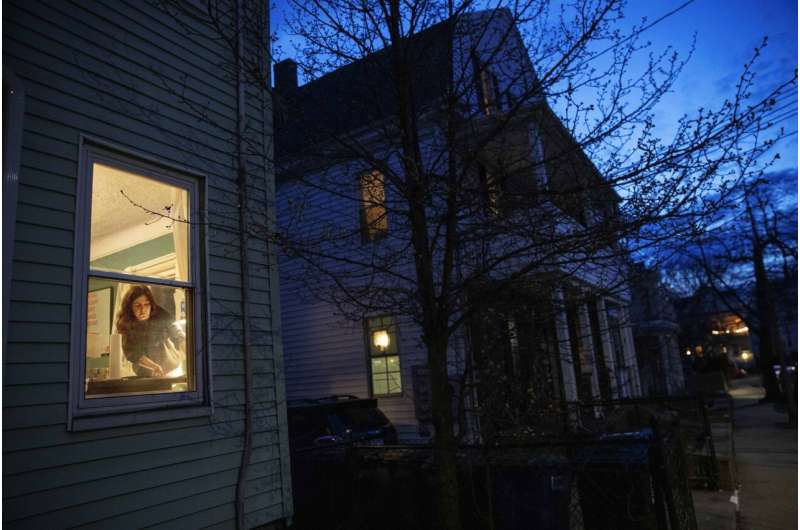
McKenna Shuster works on a linocut art print which she does as a hobby in her home on the last night of a two-week self-isolation while recovering from symptoms of COVID-19 in Somerville, Mass., on March 26, 2020. On Friday, March 1, 2024, the Centers for Disease Control and Prevention said people who test positive for COVID-19 no longer need to stay in isolation for five days. The CDC changed its longstanding guidance, saying that people can return to work or regular activities if their symptoms are mild and improving and it’s been a day since they’ve had a fever. Credit: AP Photo/David Goldman, File
Americans who test positive for COVID-19 no longer need to stay in isolation for five days, U.S. health officials announced Friday.
The Centers for Disease Control and Prevention changed its longstanding guidance, saying that people can return to work or regular activities if their symptoms are mild and improving and it’s been a day since they’ve had a fever.
The change comes at a time when COVID-19 is no longer the public health menace it once was. It dropped from being the nation’s third leading cause of death early in the pandemic to 10th last year.
Most people have some degree of immunity to the coronavirus from past vaccinations or from infections. And many people are not following the five-day isolation guidance anyway, some experts say.
“Our goal here is to continue to protect those at risk for severe illness while also reassuring folks that these recommendation are simple, clear, easy to understand, and can be followed,” said Dr. Mandy Cohen, the CDC’s director,
However, some experts worry that the change may increase the risk of infection for older people and others who are more vulnerable to getting seriously ill.
WHY ARE THE GUIDELINES CHANGING?
COVID-19 is not causing as many hospitalizations and deaths as it did in the first years of the pandemic. The change is an effort to streamline recommendations so they are similar to longstanding recommendations for flu and other respiratory viruses. Many people with a runny nose, cough or other symptoms aren’t testing to distinguish whether it’s COVID-19, flu, or something else, officials say.
It may not be as stringent, but the guidance emphasizes that all people with respiratory symptoms should stay home while they are sick, said Dr. David Margolius, the head of Cleveland’s health department.
People are likely still contagious when they test positive, and that hasn’t changed, said Jennifer Nuzzo, director of the Pandemic Center at Brown University’s School of Public Health.
“What has changed is how much COVID is harming us as a population,” Nuzzo said.
Officials noted that some other countries and California and Oregon have eased isolation guidance in a manner similar to CDC’s latest change—and did not see an increase in cases.
WHAT ARE THE NEW GUIDELINES?
If you have symptoms, stay home until your symptoms are mild and improving and it’s been a day since you’ve had a fever. But then you can remain cautious by wearing a mask and keeping a distance from others.
However, the CDC guidance for workers at nursing homes and other health care facilities is staying the same. That includes a recommendation that medical personnel stay home at least seven days after symptoms first appear, and that they test negative within two days of returning to work.
The agency is emphasizing that everyone should still try to prevent infections in the first place, by getting vaccinated, washing their hands, and taking steps to bring in more outdoor fresh air.
IS THERE OPPOSITION TO THIS CHANGE?
Yes, and even some who understand the rationale for the change have concerns.
“My biggest worry in all of this is that employers will take this change in guidance to require employees to come back to work … before they are ready to, before they feel well enough, and before they are not likely to pose harm to their co-workers,” Nuzzo said.
COVID-19 remains especially dangerous to older people and those with other medical conditions. There are still more than 20,000 hospitalizations and more than 2,000 deaths each week due to the coronavirus, according to the CDC. Those 65 and older have the highest hospitalization and death rates.
This week, the CDC said seniors should get another dose of the updated COVID-19 vaccine.
IS THIS THE FIRST CHANGE FOR ISOLATION GUIDELINES?
No. The CDC originally advised 10 days of isolation, but in late 2021 cut it to five days for Americans who catch the coronavirus and have no symptoms or only brief illnesses. Under that guidance for the general public, isolation only ended if a person had been fever-free for at least 24 hours without the use of fever-reducing medications and if other symptoms were resolving.
© 2024 The Associated Press. All rights reserved. This material may not be published, broadcast, rewritten or redistributed without permission.
Citation:
COVID-19 no longer means five days in isolation, CDC says (2024, March 1)
retrieved 1 March 2024
from https://medicalxpress.com/news/2024-03-health-day-isolation-covid.html
This document is subject to copyright. Apart from any fair dealing for the purpose of private study or research, no
part may be reproduced without the written permission. The content is provided for information purposes only.
>>> Read full article>>>
Copyright for syndicated content belongs to the linked Source : Medical Xpress – https://medicalxpress.com/news/2024-03-health-day-isolation-covid.html
